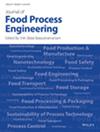Effect of drying on bioactive compounds in Eugenia uniflora fruit pulp
Abstract
Eugenia uniflora is a tropical species rich in bioactive compounds that are highly sensitive to processing conditions, particularly those involving heat. Drying is a widely used method for preserving fruit pulp which can affect the stability of these bioactive compounds. The aim of this study was to assess the impact of drying at different temperatures on the retention of phenolic compounds and carotenoids present in the pulp of E. uniflora, with the goal of optimizing the drying process to preserve the pulp's quality. The E. uniflora pulp was dried in an oven with air circulation at three temperatures (45, 65, and 85°C). During the drying process, the moisture content and concentration of phenolics, β-carotene, and lycopene were measured over time. After 260 min of drying, phenolic compounds decreased by 63.97% (45 and 65°C) and by 59.62% (85°C). Carotenoids losses were even more pronounced exceeding 89%, for all temperatures, with β-carotene reductions of 92.91%, 90.72%, and 91.11%, at 45, 65, and 85°C, respectively. Several well-established drying models were tested to represent the moisture content over time. Two models exhibited a high adherence to the experimental data. Zero-order, first-order, and second-order degradation models were used to describe the concentrations of phenolic compounds and carotenoids. For total carotenoids, the model that showed the best results was temperature-dependent. The first-order model provided the best fit for β-carotene and lycopene, with high R2 values of 0.9852 (45°C), 0.9776 (65°C), and 0.9681(85°C) for β-carotene, and 0.9776 (45°C), 0.9715 (65°C), and 0.9659 (85°C) for lycopene. These results indicate that higher temperatures accelerate the degradation of bioactive compounds, following a predictable dynamic that can be optimized through adjustments to the drying process.
Practical applications
The fruit of Eugenia uniflora contains phenolic and carotenoid compounds with significant nutraceutical potential. However, the production of this fruit is seasonal, necessitating effective preservation methods. Drying, which involves the removal of water from the pulp, is a common procedure aimed at extending the fruit's conservation and shelf life. Despite its benefits, the drying process poses a challenge, as bioactive compounds like phenolic and carotenoids are sensitive to thermal processing. Their degradation during drying can lead to a reduction in the fruit's bioactive potential. Therefore, it is crucial to understand the kinetics of drying and the degradation of these bioactive compounds to optimize the drying process and maximize the fruit's nutraceutical value.

 求助内容:
求助内容: 应助结果提醒方式:
应助结果提醒方式:


